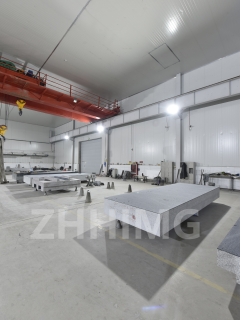Three-dimensional coordinate measurement, also known as CMM (coordinate measuring machine), is a sophisticated and advanced measurement tool that is widely used in industries such as aerospace, automotive, and manufacturing. The accuracy and precision of the measurements made by a CMM depend heavily on the machine's base or platform on which it sits. The base material should be rigid enough to provide stability and minimize any vibrations. For this reason, granite is often used as a base material for CMMs due to its high stiffness, low expansion coefficient, and excellent damping properties. However, choosing the right size of the granite base for a CMM is crucial to ensure accurate and reliable measurements. This article will provide some tips and guidelines on how to choose the right granite base size for your CMM.
Firstly, the size of the granite base should be large enough to support the weight of the CMM and provide a stable foundation. The base size should be at least 1.5 times the size of the CMM machine table. For example, if the CMM machine table measures 1500mm x 1500mm, the granite base should be at least 2250mm x 2250mm. This ensures that the CMM has enough room for movement and does not tip over or vibrate during measurement.
Secondly, the height of the granite base should be appropriate for the CMM machine's working height. The base height should be level with the operator's waist or slightly higher, so that the operator can comfortably reach the CMM and maintain a good posture. The height should also allow for easy access to the CMM machine table for loading and unloading of parts.
Thirdly, the thickness of the granite base should also be considered. A thicker base provides more stability and damping properties. The base thickness should be at least 200mm to ensure stability and minimize any vibrations. However, the base thickness should not be too thick as it can add unnecessary weight and cost. A thickness of 250mm to 300mm is typically sufficient for most CMM applications.
Finally, it is important to consider the environmental temperature and humidity when choosing the granite base size. Granite is known for its excellent thermal stability, but it can still be affected by temperature variations. The base size should be large enough to allow for temperature stabilization and minimize any thermal gradients that can affect the accuracy of measurements. Additionally, the base should be located in a dry, clean, and vibration-free environment to ensure optimal performance.
In conclusion, choosing the right granite base size for a CMM is critical for accurate and reliable measurements. A larger base size provides better stability and minimizes vibrations, while an appropriate height and thickness ensure operator comfort and stability. Consideration should also be given to environmental factors such as temperature and humidity. By following these guidelines, you can ensure that your CMM performs at its best and provides accurate measurements for your applications.
Post time: Mar-22-2024

